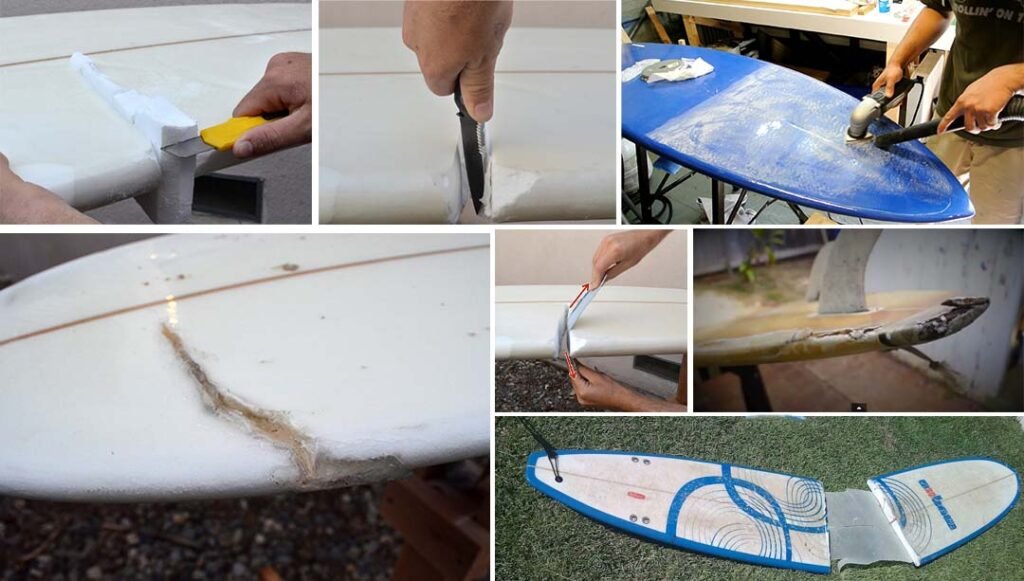As an Amazon Associate I earn from qualifying purchases.
This post contains affiliate links.
Surfing is an exhilarating water sport that brings joy and excitement to many enthusiasts. Foam surfboards, known for their buoyancy and beginner-friendly characteristics, are a popular choice among surfers. However, like any other equipment, these boards are susceptible to wear and tear. In this comprehensive guide, we will delve into the intricacies of repairing a foam surfboard, ensuring that you can extend its lifespan and continue enjoying the waves.

Understanding Foam Surfboards
Before we dive into the repair process, it’s crucial to understand the construction of foam surfboards. Most foam surfboards are made from expanded polystyrene (EPS) foam, which is then covered with a layer of fiberglass and epoxy resin. This combination provides buoyancy, durability, and maneuverability in the water.
Common Types of Damage
Foam surfboards can sustain various types of damage, ranging from minor dings to more severe cracks and breaks. Here are some common issues you might encounter:
Dings and Scratches: These are small, superficial damages to the outer layer of the board.
Cracks: More severe than dings, cracks penetrate deeper into the foam core and may affect the board’s structural integrity.
Breaks: In extreme cases, a foam surfboard may experience a complete break, separating it into two or more pieces.
Now, let’s proceed with a step-by-step guide on how to repair these issues and get your foam surfboard back in top condition.
Assessing the Damage
The first step in any repair process is to thoroughly assess the damage. Carefully examine the entire surface of the foam surfboard, paying close attention to any signs of dings, cracks, or breaks. Take note of the size and location of each issue, as this will guide your repair approach.
Gather the Necessary Materials
To repair your foam surfboard, you’ll need a few essential materials:
Sandpaper (various grits): For smoothing and preparing the damaged area.
Epoxy resin and hardener: The primary adhesive for repairing foam surfboards.
Fiberglass cloth: Provides additional strength to the repaired area.
Mixing cups and sticks: For blending and applying epoxy resin.
Masking tape: Helps create clean lines and prevents excess resin from spreading.
Acetone or rubbing alcohol: Used for cleaning and preparing the damaged area.
Utility knife: For trimming excess fiberglass and foam.
Repairing Minor Dings and Scratches
For minor surface damages like dings and scratches, follow these steps:
Clean the damaged area: Use acetone or rubbing alcohol to clean the damaged area thoroughly.
Sand the surface: Gently sand the damaged area to create a smooth and clean surface.
Apply epoxy resin: Mix epoxy resin and hardener according to the manufacturer’s instructions and apply a thin layer to the damaged area.
Sand again: Once the resin has cured, sand the repaired area to blend it seamlessly with the rest of the board.
Fixing Cracks
For more substantial damages like cracks, follow these steps:
Enlarge the crack: Use a utility knife to widen the crack slightly, creating a V-shaped groove.
Clean the area: Clean the crack and its surroundings with acetone or rubbing alcohol.
Apply epoxy resin: Mix epoxy resin and hardener and apply it to the crack, ensuring it penetrates into the groove.
Reinforce with fiberglass: Place a piece of fiberglass cloth over the crack and saturate it with epoxy resin.
Sand and finish: Once the resin has cured, sand the repaired area and finish it to match the rest of the board.
Repairing Breaks
For more severe breaks, the process is a bit more involved:
Align the pieces: If your foam surfboard has broken into pieces, align them carefully before proceeding with the repair.
Clean the surfaces: Clean the broken surfaces with acetone or rubbing alcohol.
Apply epoxy resin: Use epoxy resin to bond the pieces together. Reinforce the connection with fiberglass cloth.
Support the repair: Use masking tape or clamps to hold the pieces in place while the epoxy resin cures.
Sand and finish: Once the repair has cured, sand the area and finish it to match the rest of the board.
Repairing a foam surfboard requires attention to detail and the right materials. By following this comprehensive guide, you can address various types of damage, from minor dings to significant breaks. Regular maintenance and prompt repairs will not only extend the lifespan of your foam surfboard but also ensure a smoother and more enjoyable surfing experience. Remember, a well-maintained board is key to riding the waves with confidence and style. So, grab your tools and get ready to keep your foam surfboard in top-notch condition for countless surfing adventures to come.
As an Amazon Associate I earn from qualifying purchases.
Leave a Reply